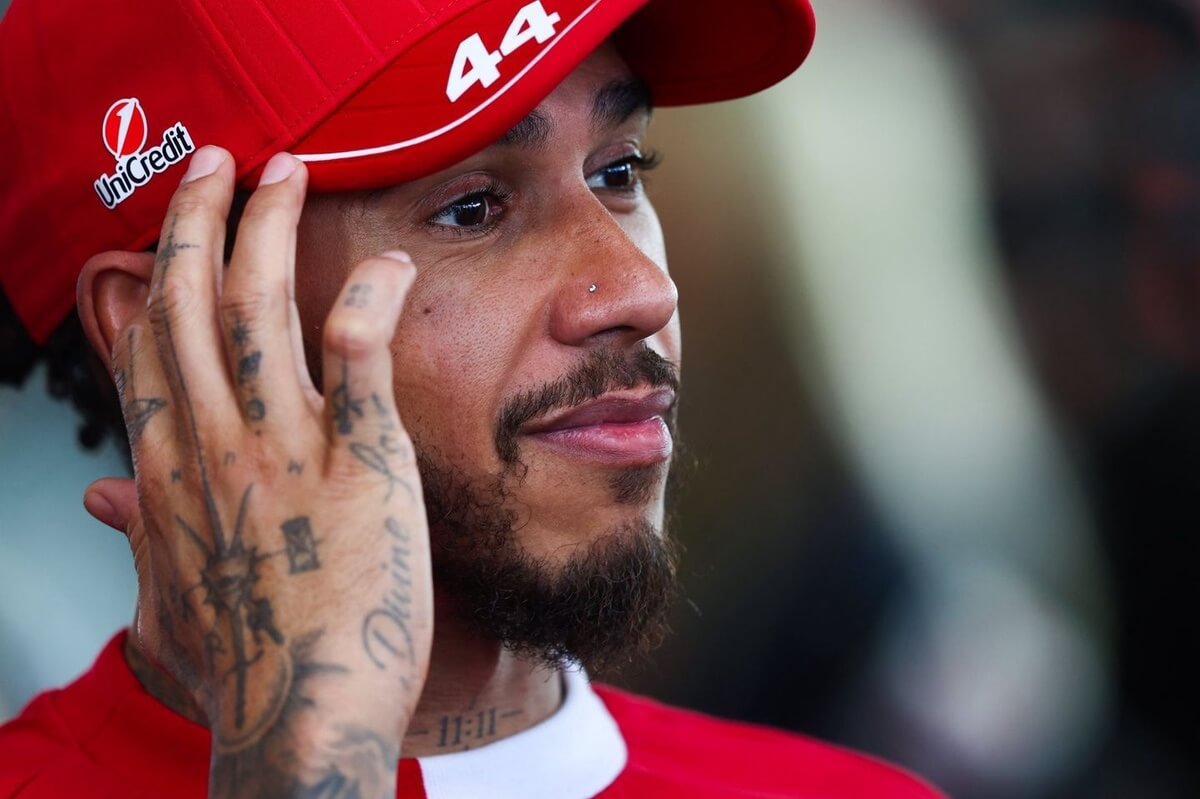world news
Lewis Hamilton and the Unexpected Groundhog Incident: A Moment of Unpredictability in F1 Racing
Introduction: The Unpredictable World of Formula 1
Formula 1 racing, known for its high speeds, precision, and intense competition, is a world where every second counts. Drivers like Lewis Hamilton are accustomed to making split-second decisions in a high-pressure environment, where the difference between winning and losing can come down to mere fractions of a second. The track itself, with its sharp corners, fast straights, and technical complexity, is always the focus, demanding total concentration and skill.
However, every so often, the unexpected happens. A moment occurs that breaks the usual flow of the race — one that is out of the hands of drivers, teams, and organizers alike. An example of this unpredictability came when Lewis Hamilton, during an F1 race, inadvertently ran over a groundhog that had made its way onto the track. This incident, while seemingly trivial in the grand scheme of a race, serves as a reminder of the many variables that can disrupt even the most meticulously planned events.
In this article, we will explore the circumstances surrounding this bizarre moment in Formula 1 racing, examine the potential consequences of such an event, and discuss how even the world’s most elite athletes face challenges that extend beyond the track. From the sheer randomness of wildlife encounters to the physical and emotional effects of unexpected obstacles, this incident illustrates how Formula 1 is more than just about racing — it’s about managing the unexpected in a world where perfection is the goal.

The Incident: Lewis Hamilton and the Groundhog Encounter
During a race that was otherwise focused on tire strategies, pit stops, and split-second overtakes, one of the most talked-about moments involved a very different kind of obstacle — a groundhog on the track. As Hamilton navigated the complex circuit, he unknowingly ran over the small animal. The impact, while not causing any immediate damage to his car, brought a momentary pause to the high-speed action. The question on everyone’s minds was how such an event might affect the race, the car, and, more importantly, the driver’s psyche.
It was a bizarre and surprising moment, as animals are not a common concern during an F1 race. Motorsport fans are used to seeing crashes, tire failures, or technical glitches, but a wild animal on the track is something entirely different. The groundhog’s presence on the circuit added an element of unpredictability, reminding everyone that Formula 1 races, no matter how carefully organized, can still be disrupted by forces beyond the control of even the most skilled drivers.
In a high-stakes environment like F1, it’s not often that a driver faces such an unusual challenge. The event served as a brief, humorous distraction in the midst of the competition. However, it also highlighted how even small, unexpected occurrences — such as an animal on the track — could pose potential risks, however minimal they may seem.
The Impact on the Race: Unforeseen Consequences and Safety Protocols
While it’s easy to laugh off the idea of a groundhog disrupting a race, there are serious implications when unexpected obstacles appear on the track. Formula 1 is an incredibly dangerous sport, and safety is always the top priority. For a driver like Hamilton, even a seemingly minor distraction can have ripple effects on their focus and performance.
Although running over the groundhog didn’t appear to have any significant impact on Hamilton’s car or performance, the event could have been much worse. Formula 1 races take place at speeds in excess of 200 miles per hour, and any obstacle on the track, whether it’s a piece of debris, a tire, or an animal, can result in catastrophic consequences. For this reason, F1 tracks are equipped with a variety of safety measures, including strict track regulations, safety barriers, and procedures for handling unforeseen circumstances.
The appearance of a groundhog on the track would likely have prompted a quick response from race officials. Immediate attention would be given to ensuring that the animal was removed safely and that the integrity of the race was not compromised. Furthermore, F1 teams have extensive protocols for such incidents. The race organizers have well-trained medical and safety teams who are prepared to respond to any situation, including unusual ones like this.
Despite the potential for chaos, the incident demonstrates how F1 teams and officials are constantly prepared for the unexpected. In a sport where danger can come from any direction — be it mechanical failure, weather conditions, or unexpected wildlife — the ability to react quickly and efficiently is crucial. While the groundhog incident might have seemed like a minor blip in the grand scheme of the race, it serves as an important reminder of the challenges that drivers and teams face beyond the racing itself.

The Psychological Aspect: Lewis Hamilton’s Focus Amidst Distraction
One of the most interesting aspects of the incident with the groundhog is how it may have affected Lewis Hamilton’s mental focus during the race. Formula 1 drivers are known for their mental toughness. They train rigorously to maintain the level of focus necessary to perform at their best during a race. Every turn, every braking point, and every acceleration is calculated with precision. Distractions are rare, but when they do occur, they can have a subtle but significant impact on a driver’s concentration.
Running over the groundhog might have briefly disrupted Hamilton’s train of thought, forcing him to recalibrate and refocus. Such distractions, however small, can throw off even the most seasoned athletes. However, Hamilton’s ability to maintain his concentration and navigate the rest of the race is a testament to his mental fortitude and experience.
It’s important to recognize that the psychological aspect of racing is just as critical as the physical. Formula 1 drivers are expected to perform under immense pressure, where every second matters. Any deviation from that precision, even one caused by an unexpected incident, can affect the outcome of the race. How a driver handles these distractions can often determine their success.
In this case, Hamilton’s reaction to the groundhog incident likely didn’t lead to a loss of focus, but it does highlight how drivers in F1 must continually manage stress, maintain mental clarity, and react to both expected and unexpected challenges.
The Broader Implications: Environmental and Wildlife Concerns on F1 Tracks
While the groundhog incident might have seemed like a lighthearted moment in the race, it also brings attention to a larger issue: the potential interaction between motorsport and wildlife. Motorsport tracks, particularly those located in rural or semi-rural areas, are sometimes close to natural habitats where animals like groundhogs, birds, and other wildlife might wander onto the track. While these incidents are rare, they do raise important questions about the environmental impact of racing events and the measures that could be taken to prevent wildlife from entering the track.
In many cases, race organizers take steps to minimize the risk of animals coming onto the track. For example, some F1 venues have fences and barriers to keep wildlife away from the racing area. Additionally, race officials and safety teams are trained to respond to such incidents to minimize any potential danger to both the participants and the animals involved.
This incident highlights the importance of balancing the needs of motorsport with environmental considerations. As F1 races grow in popularity and expand to new locations, organizers must also consider how their events impact local ecosystems. The presence of wildlife in or near race venues can serve as a reminder that nature and motorsport must coexist in a way that ensures the safety of both the participants and the environment.
Conclusion: A Surprising Moment in a High-Stakes Sport
The unexpected groundhog encounter during Lewis Hamilton’s F1 race was a strange but memorable moment in the world of motorsports. Though it didn’t result in any major consequences, it serves as a reminder of the many unpredictable factors that drivers and teams must contend with during a race. In a sport where precision, focus, and speed are paramount, even the smallest distraction can have ripple effects.
The incident also brought attention to the larger issues that affect the F1 world, from safety protocols to the balance between motorsport and the environment. It showcased the unpredictable nature of racing, and how the human element — in this case, Lewis Hamilton’s ability to stay focused — plays an important role in determining the outcome of a race.
In the end, while the groundhog’s brief appearance on the track may have been a lighthearted moment, it reinforced the idea that Formula 1 is a world where the unexpected can happen at any time. For drivers like Hamilton, it’s not just about managing the technical aspects of the race — it’s about staying prepared for whatever the race, and the world around it, throws their way.
From cdcustomtees

